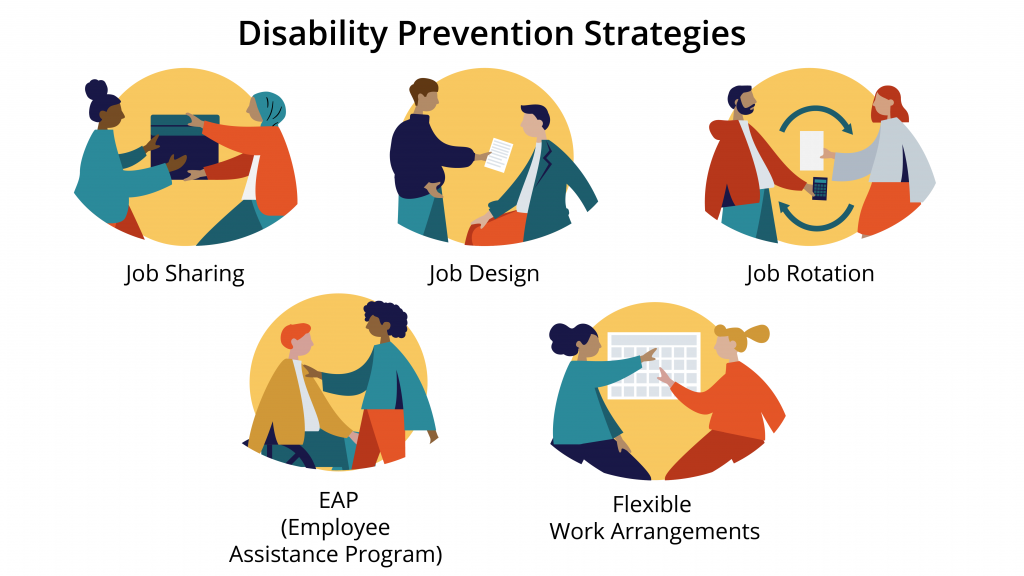10.3 Disability Prevention

While all employers have legislative obligations to prevent injury (as outlined in Chapter 2), some employees also provide an employee assistance program (EAP) as part of their disability management program. These programs normally provide access to short-term psychological counselling to help employees to cope with personal problems. The underlying logic of EAPs is that personal issues can affect work performance and, if untreated, can sometimes become more profound.
EAPs are often one aspect of workplace wellness programs. Such programs are health promotion activities designed to help workers to improve their health and well-being. These programs often focus on specific issues (e.g., smoking cessation, weight loss, stress management). Again, the underlying logic of these programs is that healthier workers will be more productive workers. It is worth noting that many of these programs help workers to adapt to workplace hazards rather than seeking to remove the hazard by modifying the work. Stress management, for example, rarely seeks to eliminate the workplace causes of stress. Instead, it seeks to help the worker cope with that stress to maintain the worker’s productivity.
Some wellness initiatives that do actually modify the workplace are things like flexible work arrangements, such as compressed workweeks. In a compressed workweek, a worker puts in slightly longer hours but fewer days per week. Some workplaces will also allow job sharing, wherein two workers share a single position with each worker working some portion of the full-time job. Another option is telecommuting, wherein workers perform work away from the office (e.g., at home). This option can allow workers to better balance otherwise conflicting work and home responsibilities.
Other wellness initiatives include job design and job rotation. In job design, department leaders work with the Human Resources department to review the makeup and expectations of a job to ensure the workload and physical requirements of the role are realistic and support good overall health. In job rotation, employers cross-train employees to rotate job coverage so no one person experiences an entire shift of heavy lifting, awkward positioning, or risk of repetitive strain injury. A different strategy for reducing the possibility of injury through interventions in workers’ personal lives is the use of alcohol and drug testing in the workplace. Some employers feel this private behaviour outside of work can affect safety at work, and therefore take steps to identify workers whose alcohol or drug use may affect their work.
A bona fide occupational requirement (BFOR) is a rule necessary for the proper performance of a job, and such a rule can prevail even if it causes otherwise prohibited discrimination. For example, it is unlawful for an employer to refuse to hire a worker because the worker is blind. Yet, if an employer were hiring a delivery driver, requiring the worker to hold a valid driver’s licence (which a blind worker cannot acquire) would be a bona fide occupational requirement. This requirement is permissible because holding a driver’s licence is rationally connected to the job and reasonably necessary for the accomplishment of a legitimate work-related purpose.
Ontario suggests a three-part test to determine if drug and alcohol testing is a BFOR:
- the standard or test has been adopted for a purpose that is rationally connected to the performance of the job
- the particular standard or test has been adopted in an honest and good faith belief that it was necessary to the fulfillment of that legitimate work-related purpose
- the standard or test is reasonably necessary to accomplish that legitimate work-related purpose (i.e., it is impossible to accommodate individual employees sharing the characteristics of the claimant without imposing undue hardship upon the employer) [1]
This approach places significant restrictions on employer drug testing. For example, drug testing typically shows the presence of drug-related residue in a worker’s system, rather than measuring the actual degree of worker impairment. Since a test that does not measure impairment cannot be rationally connected to job performance, such testing is not a BFOR. Alcohol testing after an incident, when an employer has cause to suspect impairment, or at random for workers in safety-sensitive positions, may be permissible because alcohol testing does measure impairment. It is important to be mindful that different rules may apply in different circumstances and jurisdictions.
- Ontario Human Rights Commission. (2015). Drug and alcohol testing: Basic principles. Toronto: Author. http://www.ohrc.on.ca/en/policy-drug-and-alcohol-testing/drug-and-alcohol-testing-basic-principles ↵
Employer-funded access to short-term psychological counselling to help employees to cope with personal problems.
Health and well-being services provided by or through the employer that focus on health promotion and illness prevention.
Altering the normal hours of work in order to accommodate the needs of workers.
An arrangement wherein workers work longer each day to reduce the number of days per week (or month) that they are required to work.
An arrangement wherein two workers share a single position, each working some portion of the otherwise full-time job.
A rule or requirement necessary for the proper performance of a job, which can prevail even if it causes otherwise prohibited discrimination.

